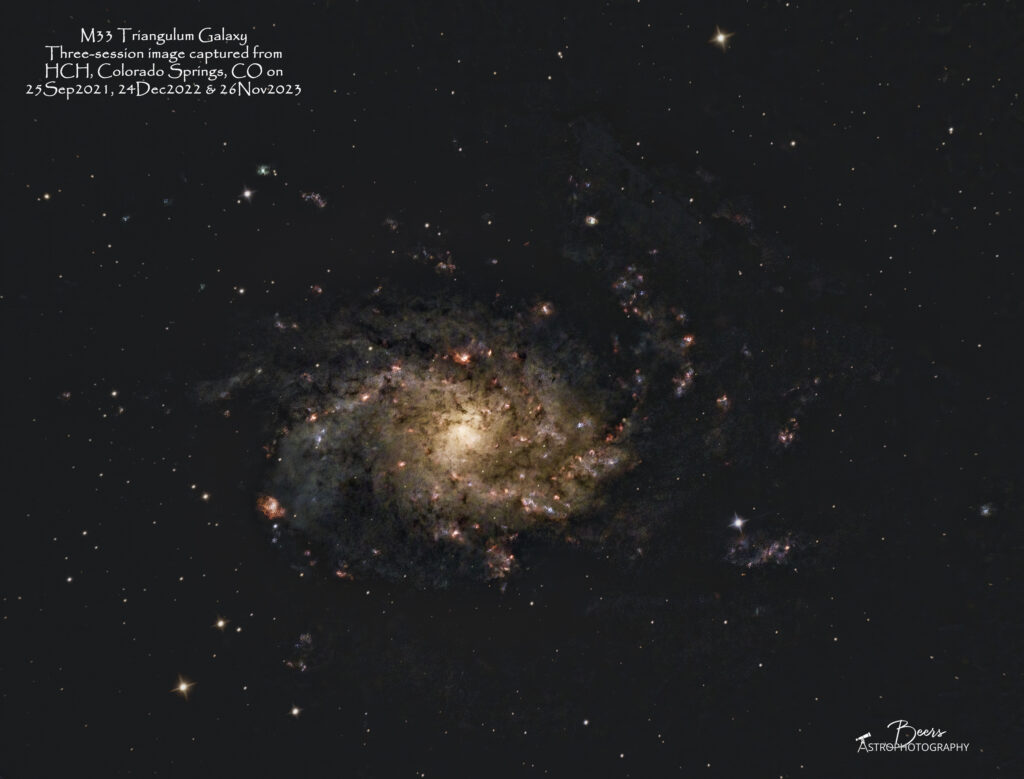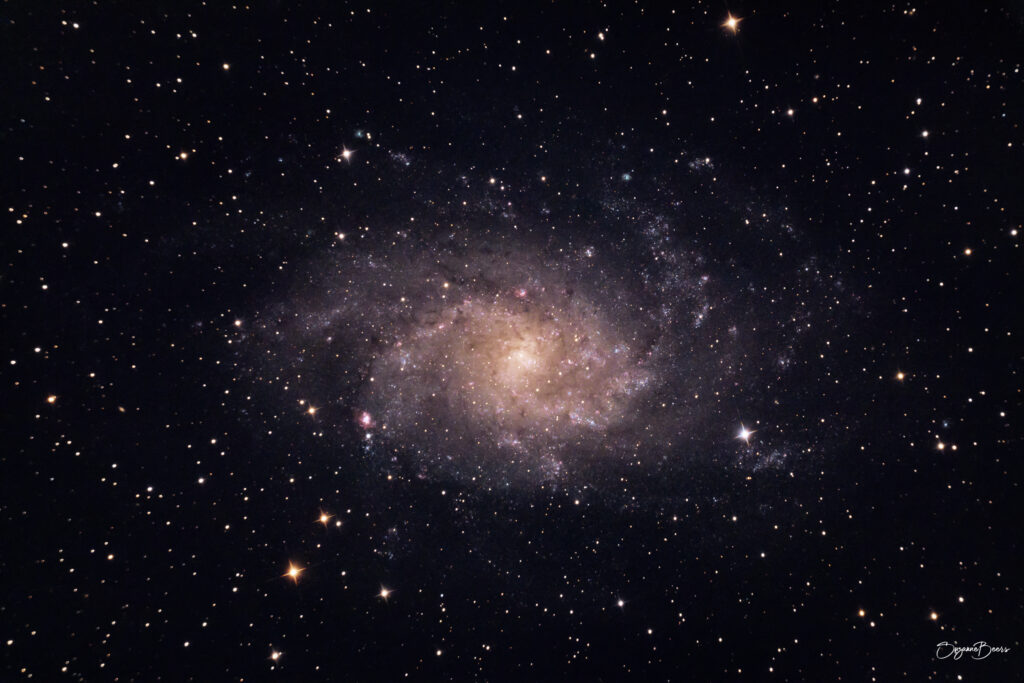
Target Fun Facts
The Triangulum Galaxy is a spiral galaxy 2.73 million light-years from Earth in the constellation Triangulum. With the D25 isophotal diameter of 61,100 light-years, the Triangulum Galaxy is the third-largest member of the Local Group of galaxies, behind the Andromeda Galaxy and the Milky Way.
The galaxy is the smallest spiral galaxy in the Local Group (although the smaller Large and Small Magellanic Clouds may have been spirals before their encounters with the Milky Way), and is believed to be a satellite of the Andromeda Galaxy or on its rebound into the latter due to their interactions, velocities, and proximity to one another in the night sky.
Other Catalog Designations: NGC 0598, MCG+05-04-069, UGC 1117, PGC 5818
Subtype: Spiral Galaxy
Distance from Earth: 2.73 million light years
Diameter: 61,120 light years
Number of stars: 40 billion
Visual Magnitude: 5.72
Constellation: Triangulum
{From https://en.wikipedia.org/wiki/Triangulum_Galaxy}
Capture & Processing Notes
M33 Triangulum Galaxy was the second target for Big Bertha on our first night at the Comanche National Grasslands Camel Rock camping site during our October dark skies trip.
After seeing the coma in the star field during the capture of IC59/IC63 (that was apparent even with the unstacked images on the laptop screen with tired eyes!), I took the field flattener off, because it seemed to be causing more problems than it was repairing. When I took the FF off, BB was substantially out of focus, so I ran the focusing sequence (Sadr) with the Bahtinov lens (that Chris Poss made for me) before launching off of capturing M33 Triangulum. By that time, the wind had picked up quite substantially and blew throughout the night, which probably effected the quality of the star field in M33 – which seem to be in focus (judging by the star diffraction spikes) but somewhat oblong shaped and traily. But, the power from the power panel through the power booster kept all the equipment (RST-300 mount, ASI2400MC camera, and laptop) working perfectly throughout the night.
Sequence Plan (5Oct2024): Gain: 158, Temp: -0°C, offset=30. 49x300sec. Total: 245 minutes (4:05hrs). Captured 6Oct2024, 01:15MDT – 6Oct2024, 05:54MDT.
Processing: Captured in SGP, stacked in APP (Adaptive Airy Disc), star removal with Starnet++, processing with LR/PS
Equipment
All equipment controlled by HP Probook running Sequence Generator Pro v4.4.1.1441.
- Autoguiding: Orion 60mm Multi-Use Guide Scope with Orion StarShoot AutoGuider Pro Mono Astrophotography Camera (controlled by PHD2)
- Imaging: ZWO ASI2400MC imaging camera on (Big Bertha) Orion 8″ f/8 Ritchey-Chretien Astrograph Telescope (Took off the Teleskop Service Flattener 1.0x for RC Telescopes (TS-RCFLAT2) because of the terrible coma it was creating in the star field throughout the image with IC59/IC63 the first target of the night.)
- Autofocuser: ZWO EAF Electronic Automatic Focuser (EAF-5V-STD) (Didn’t use the autofocuser on the first night because finished set-up in the dark)
- Mount: Rainbow Astro RST-300 (controlled by iHubo ASCOM driver)
- Polar alignment: QHYCCD camera (controlled by Polemaster for polar alignment)
Summary
Sequence Plan (5Oct2024): Gain: 158, Temp: -0°C, offset=30. 49x300sec. Total: 245 minutes (4:05hrs). Captured 6Oct2024, 01:15MDT – 6Oct2024, 05:54MDT.
Shooting Location: Comanche National Grasslands’ Camel Rock, Colorado
Equipment: Big Bertha (on RST-300 mount)
Processing: Captured in SGP, stacked in APP (Adaptive Airy Disc), star removal with Starnet++, processing with LR/PS
Other images of M33 Triangulum Galaxy
Multi-session image and its constituent individual session images captured from HCH: 2021-2023

The images below are the individual session images. The data these three individual images (session) were combined in APP to create the three session image at the top of this gallery page.



Capture & processing notes
Multi-session Notes: When Mother Nature cancels your dark skies camping and astrophotography imaging trip for the 11th time out of 12 months (this year), what do you do? You spend the time that you were going to take off from work catching up on processing.
I’d done some imaging on the Thanksgiving weekend, but hadn’t had a chance to process the data. I first processed the 26Nov2023 data of M33 Triangulum. It was captured during an essentially Full Moon (98.5% Waxing Gibbous) from the front patio, requiring the use of the Optolong LeXtreme filter. That filter does a great job of blocking out light pollution, but also “blocks” all colors but red. After I finished processing that image, I looked back at the previous images I’d captured (one per year in 2022 and 2021). Although they were also captured from the front patio, they had much more color. The 25Sep2021 was captured with the Canon EOS Ra at ISO800 without any light pollution filters because I didn’t own any at that point. The 24Dec2022 image was captured with the Canon EOS Ra at ISO3200 with the LPro filter because it was essentially New Moon (1.3% Waxing Crescent).
So, I decided to combine all the data from those three imaging sessions together to see what the result might look like. Astro Pixel Processor (APP) does an amazing job of stacking diverse images. In this case it combined data captured using Canon EOS Ra and ASI2400 MC cameras; Big Bertha and Big Zeus telescopes; no, LPro, and LeXtreme filters, and with/without the Field Flattener. The resulting stack did have a bit of a “Frankenstein” look to it, because of the different framing angles used in each session. But the colors did come through…as you can see in the three-session image above.
Capture Notes (25Sep2021): I wasn’t keeping a detailed journal during 2021 – so I just have the images in my “My Astrophotography Journey – Year One” document. That first year, unlike 2023’s dismally small amount of time spent in dark skies, was rich with dark sky camping and imaging time. We went to Mills Canyon Rim in the Kiowa National Grasslands in early September (5-9Sep2021) and early November (3-6Nov2021). The image of M33 was captured from the HCH front patio on 25Sep2021 during a 83.3% Waning Gibbous, with no light pollution filters (didn’t own any). Showing that dropping the ISO and exposure time (ISO800, 180sec exposures) does really work well to allow you to capture images through (natural and man-made) light pollution.
Capture Notes (24Dec2022): We had a clear night on Christmas Eve. After our guests left after our Christmas Eve dinner, I decided to take advantage of it, as it seems that it is the last predicted one for this year – and well into January 2023. I had been working on the putting content into the website and realized that the version of M33 Triangulum Galaxy was okay (and I put it in there as a placeholder) but it could definitely benefit from more data and better capture and processing techniques that I’ve learned since that image was captured on 25 September 2021.
Capture Notes (26Nov2023): This was the ZWO EAF autofocuser’s “first light” after Paul had developed a way to attach it to Big Bertha. I was baffled, during the collect, why the autofocus chart, that is supposed to look like a hyperbola (setting the focus at the minimum point of the average star size (measured as half flux radius (HFR)) was a straight line. The next morning, after reaching out to a couple of forums (Starry Nights responses being especially useless) and an email to Nico Carver (who said, “It sounds like a mechanical issue. Is the focusing tube moving when the knobs do?”). Nico was correct. When I told Paul that the screw connecting the EAF bracket to the focuser tube should not be too long so as to lock down the focusing mechanism, I had it exactly wrong. It turns out the screw on the bottom of the focuser is needed to provide the tension, so that the focusing tube actually moves when the focusing knob does! Lesson learned – luckily on the front patio (during a full moon) and not during precious dark skies time.
Sequence plans included in the multi-session image:
Sequence plan (25Sep2021): ISO800; 54x180sec; captured 25Sep2021, 2355MST – 26Sep2021, 0248MST. Total exposure time: 2:42hrs.
Sequence plan (24Dec2022): ISO3200; 59x180sec; captured 24Dec2022 2157MST – 25Dec2022, 0106MST. Total exposure time: 2:57hrs.
Sequence plan (26Nov2023): Gain 158, Offset 30, Temp 0°C; 73x5min. Captured 26Nov2023, 1830MST – 27Nov2023, 0201MST. Total exposure time: 6:05hrs.
Total data included in multi-session image: 113x3min + 73x5min = 704min (11:44hours)
Equipment
All equipment controlled by HP Probook running Sequence Generator Pro
Imaging:
Ra-BB (25Sep2021): Canon EOS Ra; Orion 8″ f/8 Ritchey-Chretien Astrograph Telescope
Ra-BZ-FF-LPro (24Dec2022): Orion 10″ f/8 Ritchey-Chretien Astrograph Telescope; Canon EOS Ra with with Teleskop Service Flattener 1.0x for RC Telescopes (TS-RCFLAT2) and Optolong L-Pro LP filter
ASI2400-BB-FF-LeX-EAF (26Nov2023): ZWO ASI2400MC imaging camera with Teleskop Service Flattener 1.0x for RC Telescopes (TS-RCFLAT2) and Optolong L-Extreme LP filter; Orion 8″ f/8 Ritchey-Chretien Astrograph Telescope; ZWO EAF Electronic Automatic Focuser – Standard (New 5V Version) (EAF-5V-STD)
Mount: Sky-Watcher EQ6-R Pro Equatorial Mount (controlled by EQMOD)
Polar alignment: QHYCCD camera (controlled by Polemaster for polar alignment)
Autoguiding: Orion 60mm Multi-Use Guide Scope with Orion StarShoot AutoGuider Pro Mono Astrophotography Camera (controlled by PHD2);
